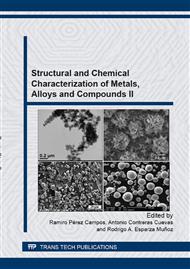[1]
S.A. Alidokht, A. Abdollah-zadeh, H. Assadi, Effect of applied load on the dry sliding wear behaviour and the subsurface deformation on hybrid metal matrix composite, Wear 305 (2013) 291–298.
DOI: 10.1016/j.wear.2012.11.043
Google Scholar
[2]
Patrick W. Leech, Xing S. Li, Nazmul Alam, Comparison of abrasive wear of a complex high alloy hardfacing deposit and WC–Ni based metal matrix composite, Wear 294–295 (2012) 380–386.
DOI: 10.1016/j.wear.2012.07.015
Google Scholar
[3]
M Audronis, O Jimenez, A Leyland and A Matthews, The morphology and structure of PVD ZrN–Cu thin films, J. Phys. D: Appl. Phys. 42 (2009) 085308.
DOI: 10.1088/0022-3727/42/8/085308
Google Scholar
[4]
Y. Kevin Chou, Raymond G. Thompson, Ashok Kumar, CVD-diamond technologies for dry drilling applications, Thin Solid Films 518 (2010) 7487–7491.
DOI: 10.1016/j.tsf.2010.05.031
Google Scholar
[5]
O. Guillon, S. Krauß, J. Rödel, Influence of thickness on the constrained sintering of alumina films, J. Eur. Cer. Soc. 27 (2007) 2623–2627.
DOI: 10.1016/j.jeurceramsoc.2006.10.007
Google Scholar
[6]
J. Kim, R.A. Rudkin, X. Wang, A. Atkinson, Constrained sintering kinetics of 3YSZ films, J. Eur. Cer. Soc. 31 (2011) 2231–2239.
DOI: 10.1016/j.jeurceramsoc.2011.05.044
Google Scholar
[7]
D. Bernard, O. Guillon, N. Combaret , E. Plougonven, Constrained sintering of glass films: Microstructure evolution assessed through synchrotron computed microtomography, Acta Mater. 59 (2011) 6228–6238.
DOI: 10.1016/j.actamat.2011.06.022
Google Scholar
[8]
J. Wallot, P. Reynders, A. A. Herzing, C. J. Kiely, M. P. Harmer, J. Rödel, Sintering of thin film nanocrystalline titania–tin oxide composites, J. Eur. Cer. Soc. 28 (2008) 2225–2232.
DOI: 10.1016/j.jeurceramsoc.2008.02.019
Google Scholar
[9]
D.J. Green, O. Guillon, J Rödel, Constrained sintering: A delicate balance of scales, J. Eur. Cer. Soc. 28 (2008) 1451–1466.
DOI: 10.1016/j.jeurceramsoc.2007.12.012
Google Scholar
[10]
C. Jamin, T. Rasp, T. Kraft, O. Guillon, Constrained sintering of alumina stripe patterns on rigid substrates: Effect of stripe geometry, J. Eur. Cer. Soc. 33 (2013) 3221–3230.
DOI: 10.1016/j.jeurceramsoc.2013.06.016
Google Scholar
[11]
R. Huang, J. Pan, A further report on finite element analysis of sintering deformation using densification data—Error estimation and constrained sintering, J. Eur. Cer. Soc. 28 (2008) 1931–1939.
DOI: 10.1016/j.jeurceramsoc.2008.01.016
Google Scholar
[12]
C.L. Martin, R.K. Bordia, The effect of a substrate on the sintering of constrained films, Acta Mater. 57 (2009) 549–558.
DOI: 10.1016/j.actamat.2008.09.041
Google Scholar
[13]
F. Li, J. Pan, O. Guillon, A. Cocks, Predicting sintering deformation of ceramic film constrained by rigid substrate using anisotropic constitutive law, Acta Mater. 58 (2010) 5980–5988.
DOI: 10.1016/j.actamat.2010.07.015
Google Scholar
[14]
Z. Yan, C.L. Martin, O. Guillon and D. Bouvard, Effect of size and homogeneity of rigid inclusions on the sintering of composites, Scripta Mater. 69 (2013) 327–330.
DOI: 10.1016/j.scriptamat.2013.05.013
Google Scholar
[15]
L. Olmos, C.L. Martin, D. Bouvard, Sintering of mixtures of powders: Experiments and modeling, Powder Technol. 190 (2009) 134.
DOI: 10.1016/j.powtec.2008.04.057
Google Scholar
[16]
T. Rasp, C. Jamin, A. Wonisch, T. Kraft, O. Guillon, Shape distortion and delamination during constrained sintering of ceramic stripes: Discrete element simulations and experiments, J. Am. Cer. Soc. 95 (2012) 586–592.
DOI: 10.1111/j.1551-2916.2011.04939.x
Google Scholar
[17]
L. Amaral, C. Jamin, A.M.R. Senos, P.M. Vilarinho, O. Guillon, Constrained sintering of BaLa4Ti4O15 thick films: Pore and grain anisotropy, J. Eur. Cer. Soc. 33 (2013) 1801–1808.
DOI: 10.1016/j.jeurceramsoc.2013.01.031
Google Scholar


